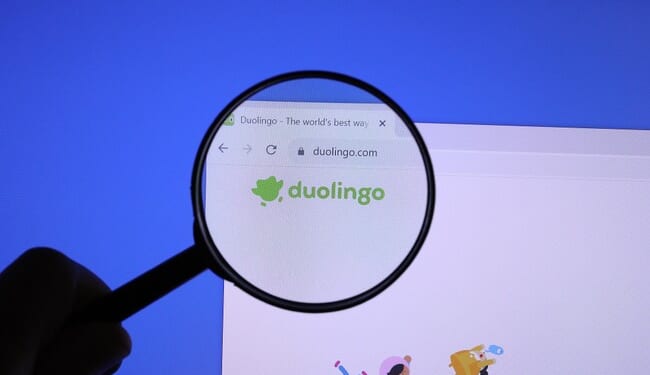
For about a year, I learned foreign languages with Duolingo. I spent extensive time working on Spanish and Japanese, and I dabbled in Welsh, Hebrew, and Italian. Duolingo is an effective and often fun way of learning a new language, despite some annoyances. For starters, Duolingo likes to send way too many notifications. Almost every day without fail, I would get a notification before 7:30 in the morning calling me out for not already spending hours on the app.
But there was another thing I noticed early on about Duolingo: there was an awful lot of gayness in the lessons and exercises. I wrote about it last May:
Here’s an example: on Saturday morning, I did a speaking lesson. The way those work is that you have 10 sentences that you have to listen to and speak back. Duolingo has these cartoon characters (which are politically correct enough that one of them wears a burka) that you encounter throughout your journey on the app or website, and they’re the ones to speak what you must speak back.
In this particular lesson, two of the exercises had male characters talking about “mi novio” (my boyfriend). Another male character spoke about “mi esposo” (my husband), while a female character said something about “mi esposa” (my wife). If you’re keeping score, that’s four out of 10 exercises dealing with same-sex relationships.
Lest you think that this is some special phenomenon for Pride Month Advent, I’ve noticed several gay and lesbian exercises throughout my time using the app. While none of the characters are explicitly gay in and of themselves — though I have my doubts about one of them — many of the characters will blurt out a sentence about a same-sex relationship from time to time.
I also wrote about the reading comprehension stories that featured lesbian characters. As I advanced in my language learning, I noticed that there were a lot of sentences about men buying skirts. (Come to think of it, there was a preponderance of exercises about people of both sexes buying skirts. Do people travel to Spanish-speaking countries for the express purpose of buying skirts?)
Related: You Can’t Escape the Pride Cult Even When You’re Trying to Learn Another Language
For months, I didn’t think about it as anything other than something to make fun of. But this weekend, I stumbled on a tweet that Libs of TikTok posted on Friday, which exposed the truth: all of the gay content in Duolingo is by design. The tweet includes screenshots of a blog post crowing about how Duolingo is all about “normalizing queerness.”
The word “queerness” is what triggers my spidey senses. I don’t remember if I’ve written this here at PJ Media, but I’ve often said out loud that my definition of “queer” is “gay with an agenda.” So to see the emphasis on “queer” characters tells us what we need to know.
It took me a while to find the blog post, so at first, I thought surely Duolingo deleted it when Libs of TikTok exposed the agenda. I scrolled past language-learning recommendations for Ramadan — “a time of self-discipline and character-building” — but no other religious holidays and celebrations of the Ukrainian language after Russia’s invasion but nothing about Hebrew after Hamas’ atrocities.
I passed posts about gender-inclusive language — including the insistence that “they” as a singular pronoun has been around for a while. I saw one about how “power struggles” affect language and another about creating the female Duolingo characters “while also writing against stereotypes.” There was also a post introducing “some of our LGBTQ employees” complete with explanations of how they identify. The blog as a whole dripped with leftist tropes and coded language, and it translates over to Duolingo’s social media.
Language learning is for everyone and inclusivity matters. 💚
From our in-app lessons to affinity groups for our employees, we believe in the power of representation and giving a voice to the LGBTQ+ community!
Here are some of the phrases you can learn with us. 🏳️🌈 pic.twitter.com/CGNy29QnUf
— Duolingo (@duolingo) June 8, 2021
I finally found the post from way back in June 2021 — that’s right, during the high holy days of Pride Month. Duolingo declares near the top of the post that it has “a responsibility to reflect and relate to the experiences of all kinds of people, LGBTQIA+ folks included.”
The author later tells us that “characters are also much more compelling when they’re relatable, not only because of their dreams and their flaws but also who they love.” Sorry, but in all my years of reading and writing, I’ve never expressed any desire for stories to reflect “who I love.” That idea smacks of an agenda.
“We have three established queer characters: Lin, Bea, and Oscar,” Duolingo informs us before going way TMI. “Lin dates women, Bea dates both men and women, and Oscar’s into men (although he’s as discerning with men as he is with his cheeses and pretty much everything else).”
This, of course, is all about “inclusive representation,” but it’s not just those three characters making “queer” statements all over the app. The other characters also appear in exercises representing same-sex relationships and men buying and wearing women’s clothing. Here’s the thing: if it happens once in a while, it’s inclusion, but if it’s showing up all the time, it’s an agenda. And as with so many left-leaning companies, Duolingo’s agenda is showing.

